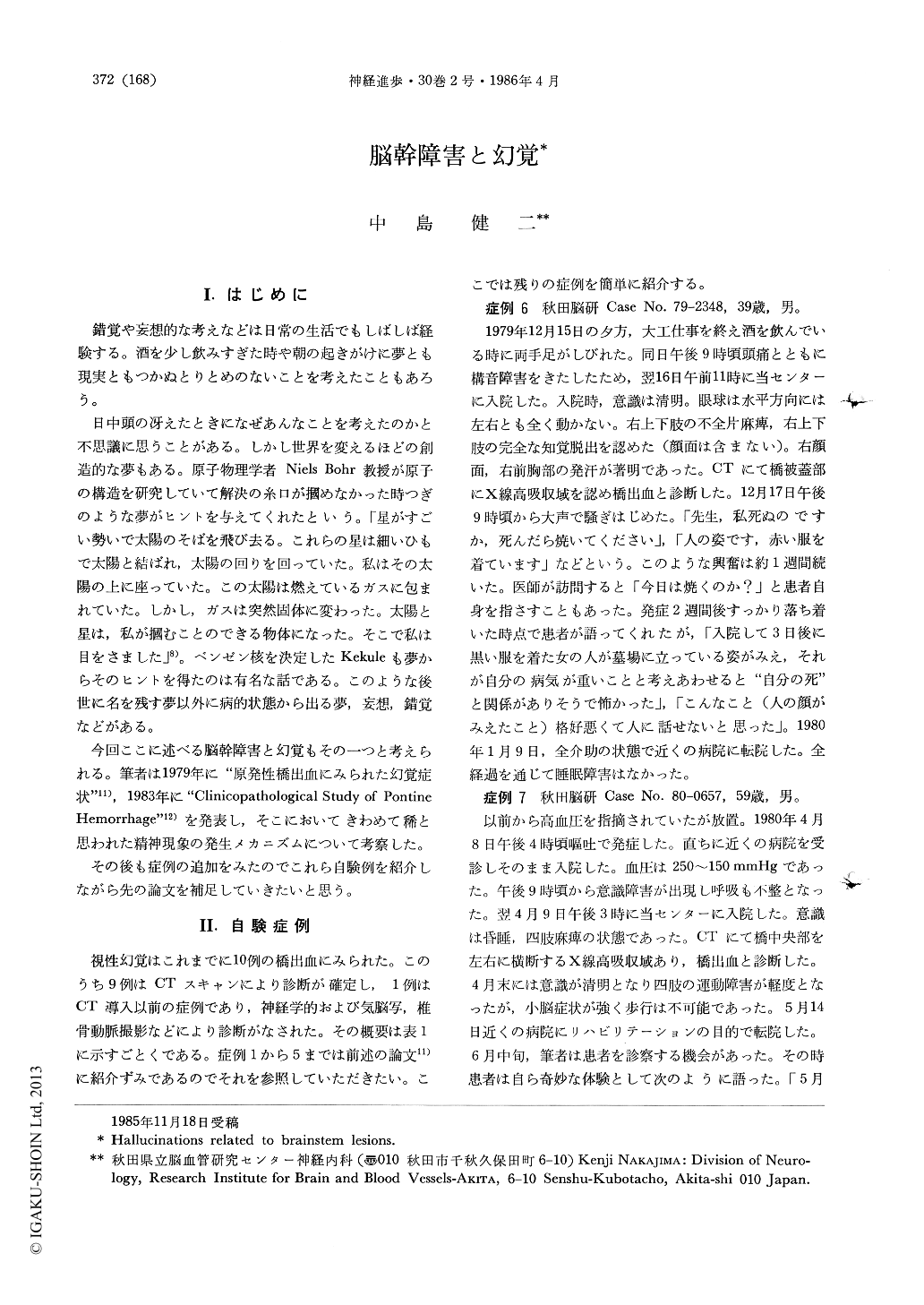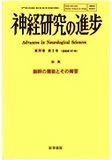Japanese
English
- 有料閲覧
- Abstract 文献概要
- 1ページ目 Look Inside
I.はじめに
錯覚や妄想的な考えなどは日常の生活でもしばしば経験する。酒を少し飲みすぎた時や朝の起きがけに夢とも現実ともつかぬとりとめのないことを考えたこともあろう。
日中頭の冴えたときになぜあんなことを考えたのかと不思議に思うことがある。しかし世界を変えるほどの創造的な夢もある。原子物理学者Niels Bohr教授が原子の構造を研究していて解決の糸口が掴めなかった時つぎのような夢がヒントを与えてくれたという。「星がすごい勢いで太陽のそばを飛び去る。これらの星は細いひもで太陽と結ばれ,太陽の回りを回っていた。私はその太陽の上に座っていた。この太陽は燃えているガスに包まれていた。しかし,ガスは突然固体に変わった。太陽と星は,私が掴むことのできる物体になった。そこで私は目をさました」8)。ベンゼン核を決定したKekuleも夢からそのヒントを得たのは有名な話である。このような後世に名を残す夢以外に病的状態から出る夢,妄想,錯覚などがある。
Lesions in the brainstem may reveal many neurological symptoms. They are pyramidal tract sign, sensory disturbance, cerebellar sign, cranial nerve signs, etc. Not only these neurological signs, but also psychiatric signs have been observed and reported. The hallucination is one of them. The author experienced visual hallucinations in 10 cases of pontine hemorrhage out of over one hundred pontine hemorrhages. The diagnosis of pontine hemorrhage was confirmed by CT scanner in 9 cases and by pneumoencephalogram in one case. All 10 cases showed mild clinical course.
The contents of hallucinations were visual and colorful in all cases. Some were very familiar such as "green coach", "colored kettle and bucket", "landscape of neighbours", "dark brown roofs", "many fish", "white dogs", "red glowing stove", "green mosquito net", "cockroaches and ants", etc. Others were very curious; "black and white striped serpent on the wall of the building","women in the black dress standing in the grave", "brown colored water sprites", etc. The patients experienced these psychic phenomena 5 to 50 days after the stroke and lasted several days. While these hallucinations occured, patients looked like bystanders and they could explain the contents coolly and were never influenced by the halluci-nations except two cases; one patient ran around the hospital room unfolding a towel in order to catch fish and other one cried out all night being afraid of being carried to the grave. Including these two patients, all patients were or became critical for their observations. Psychic phenomena such as hallucinations, illucious, etc have been in-vestigated in many ways; psychological, psychopa-thological, neurophysiological and neurochemical. Among them, much attention has been paid on the psychopathological way, because hallucinations (visual, auditory and tactile) are one of the main symptoms of schizophrenics. But recent study revealed that these psychic phenomena are obser-ved not only in mental diseases, but also in an abuse of anesthetics, alcohol, barbiturates and in the state of starvation. It is well known that hallucinogens such as LSD and mescaline often induce hallucinatory state. Besides, hallucina-tions can be experimentally produced by sleep and sensory deprivation. As for the brain lesion, both cortical and subcortical regions are considered to be important as the cause of organic halluci-nations. Usually, cortical regions are devided into tow groups; occipital and temporal lobe. Occipital lobe hallucinations show the simple form of flashing lights or twinkling stars, whereas temporal lobe hallucinations show more complex scine such as animals, persons, landscapes, etc. Brainstem hallucination, a synonym of subcortical hallucination, was first reported by Lhermitte in 1922 as the title of "hallucinose pedonclaire". He ascribed the cause of such hallucinations to the disturbance of sleep regulatory center in the brainstem. According to him, dysregulation of sleep center may cause the leakage of the dream. Today the mechanism of sleep and awake system has been made clear and the thought that the reticular activating system in the midbrain plays the important role is widely accepted. The present 10 cases had definite lesions in the brainstem (the main region was pons to upper pons). All patients had no past history of mental illness and they never complained the same symptoms after dis-charge. Basically, the present 10 cases share the same cause for the occurence of hallucinations with Lhermitte's case.

Copyright © 1986, Igaku-Shoin Ltd. All rights reserved.


